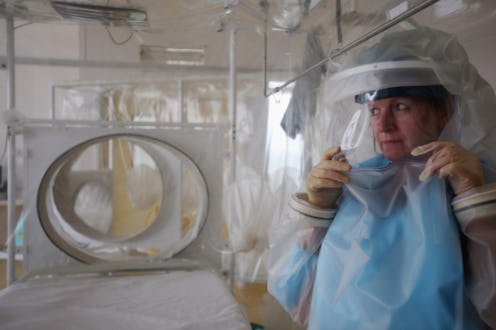News
Is Dallas Prepared For Ebola?
Thirteen really is the unluckiest number. After 12 other Americans tested negative for the virus since July 27, on Tuesday, the first confirmed case of Ebola was reported in Dallas, Texas. Now, after months of being separated by an ocean, and what seemed like a world, from the disease, Ebola is finally at our doorstep. The appearance of the virus in the United States has been anticipated for a few weeks — it was called an "eventuality" at a recent Senate hearing — but even so, it does not seem as though Americans are mentally prepared for the realization that Ebola now, more than ever, may be an eminent threat. But regardless of our individual preparedness for the news, we are all asking one terrifying question — how prepared are our hospitals?
The Texas Health Presbyterian Hospital released a statement on Monday in which they revealed that a patient was undergoing testing for Ebola and that the person remained in "strict isolation." The patient's symptoms and travel history led doctors to believe that the chances of a positive test were significant, and 24 hours later, their concerns were confirmed.
But Zachary Thompson, the director of the Dallas County Health & Human Service, told a local Dallas news station that the hospital is well-prepared for the care and treatment of the virus. "This is not Africa," he said. "We have a great infrastructure to deal with an outbreak." Representatives of the Centers for Disease Control and Prevention are already en route to the large Texas city, and seem to be coordinating a swift and measured response.
To assuage Dallas residents' fears of catching the disease themselves, Thompson noted,
Unless you have exchanged bodily fluids with this individual this is a low risk for people in Dallas County. So we want to ease the fear. We're talking about bodily fluids transmission, not just sitting right here together that being an issue.
While Ebola has spread throughout Africa with alarming rapidity, it is highly unlikely the same scenario will play out in Texas or the United States at large. One of the major factors in Ebola's African prevalence is the dire lack of sanitation equipment, including running water, sufficient protective gear, as well as physical space to house ailing patients. Moreover, poor infrastructure and a hot climate have contributed to further issues with disease containment.
For example, American doctor Rick Sacra was infected nearly a month ago in the obstetrics unit of a Liberian hospital, which was far removed from the Ebola unit. But due to sticky, humid, equatorial conditions, many health personnel failed to wear their protective gear at all times, contributing to the rapid and often far-reaching spread of the virus.
Luckily, in the air-conditioned units of American hospitals, this will likely be a non-issue in the care of this patient.
Moreover, all three Americans who were infected with Ebola after their work in Africa who have subsequently returned home for treatment have made full recoveries. Dr. Kent Brantly and Nancy Writebol were treated with the experimental (and no longer available) drug ZMapp, while Dr. Sacra was given a transfusion of Brantly's blood. As such, it seems that American healthcare workers are well aware of how to treat the disease, particularly in isolated cases.
As far as next steps are concerned, Thompson and his colleagues in Dallas have already set forth a plan of action, noting that significant research will need be done to ensure that the case is isolated and contained. In an interview with local news station CBS 11, Thompson said,
...we have to do the public health follow-up to see what contacts, where this individual has gone since they arrived here in Dallas. There are a number of things that have to be looked at.
As for the United States at large, the country has a number of facilities that are well-equipped to handle a potential outbreak. There is the Nebraska Medical Center in Omaha, where Sacra was treated, which houses a biocontainment unit described by the associate medical director as "one of the safest places in the country." It is the largest in the country, with 10 beds, and is "a secure, air-locked facility and operates on an air handling system that’s separate from the rest of the organization." The facility is 10 years old, and its staff has "received many hours of highly specialized training and detailed instruction on how to care for these types of seriously ill patients."
There are also National Institutes of Health facilities in both Maryland and Montana, both of which boast similar containment units. Just a few days ago, another American exposed to the virus in Sierra Leone was admitted to the Maryland branch. Scientists at the Montana outlet have also have a specific department dedicated to the study of infectious disease, complete with state of the art "maximum-containment laboratories [that] allows scientists to use advanced technology in their quest to protect people from the emerging infectious diseases."
Finally, Emory University, which treated Brantly and Writebol, also maintains a highly sophisticated containment unit that the university told reporters "is physically separate from other patient areas and has unique equipment and infrastructure that provide an extraordinarily high level of clinical isolation." The CDC has also released safety guidelines for hospitals without such units to eliminate the risk of spreading the disease.
So while Ebola may have made landfall in the US, the time for panic certainly has not.
Image: Getty Images (4)
